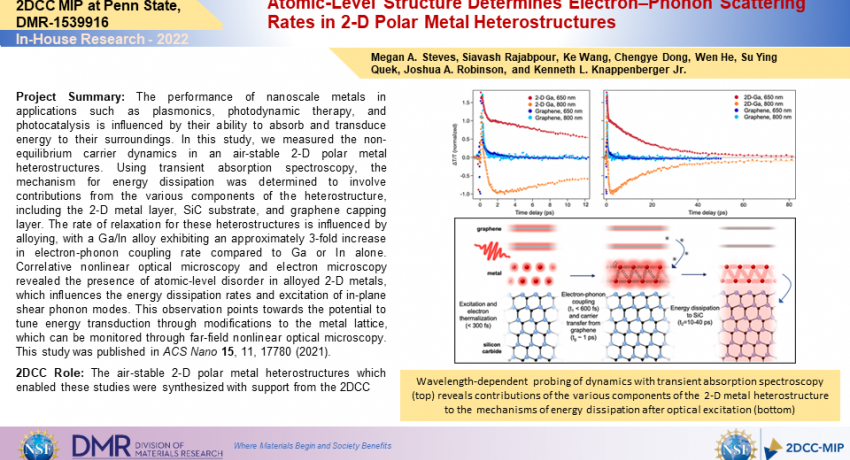What Has Been Achieved:
The mechanism of energy dissipation in 2D metal heterostructures was determined using transient absorption spectroscopy, which involves contributions from the various components of the heterostructure on sub-picosecond, picosecond, and 10s of picosecond timescales. The rates of relaxation are dependent on the structure of the 2Dmetal, with Ga/In alloys exhibiting faster rates of electron-phonon scattering than In or Ga alone. Correlative nonlinear optical microscopy and electron microscopy revealed increased structural disorder in the Ga/In alloy, explaining the faster relaxation.
Importance of the Achievement:
While the energy dissipation dynamics bulk coinage metals have been extensively studied, the effects of 2D confinement on metals has not been understood. This work reveals the impact that atomic-level structural disorder has on the dynamics of 2D metal heterostructures, and suggests avenues for controlling energy dissipation through alloying. Additionally, graphene-metal charge transfer was resolved in these systems, which could reduce thermal fouling in graphene-based technologies.
Unique Feature(s) of the MIP that Enabled this Achievement:
The synthesis of 2D-polar metal heterostructures, which represent an attractive system for studying 2D metal dynamics due to their large lateral dimensions and air stability, was enabled by the 2DCC
Publication:
Megan A. Steves, Siavash Rajabpour, Ke Wang, Chengye Dong, Wen He, Su Ying Quek, Joshua A. Robinson, and Kenneth L. Knappenberger Jr., ACS Nano 15, 11, 17780 (2021). DOI:10.1021/acsnano.1c05944
This work was supported by a grant from the Air Force Office of Scientific Research (FA-9550-18-1-0347 and FA9550-19-1-0295) and by the National Science Foundation Graduate Research Fellowship Program under grant no. DGE1255832. This work was also supported by the National Science Foundation under award number CHE-1807999, DMR-2011839, and cooperative agreement DMR-1539916. Funding was also provided by the Singapore National Research Foundation, Prime Minister’s Office, under its medium-sized center program. Calculations were performed on the NUS Graphene Research Centre cluster and National Supercomputing Centre Singapore (NSCC).
Credits/Names: Megan A. Steves, Siavash Rajabpour, Ke Wang, Chengye Dong, Wen He, Su Ying Quek, Joshua A. Robinson, and Kenneth L. Knappenberger Jr.
Download PDF Version: 1539916_2DCCMIP_2022_Phonon Scattering Rates in 2-D Polar Metal Heterostructures.pdf
Year of Research Highlight: 2021
Select a Highlight Type: In-House Research Highlight
